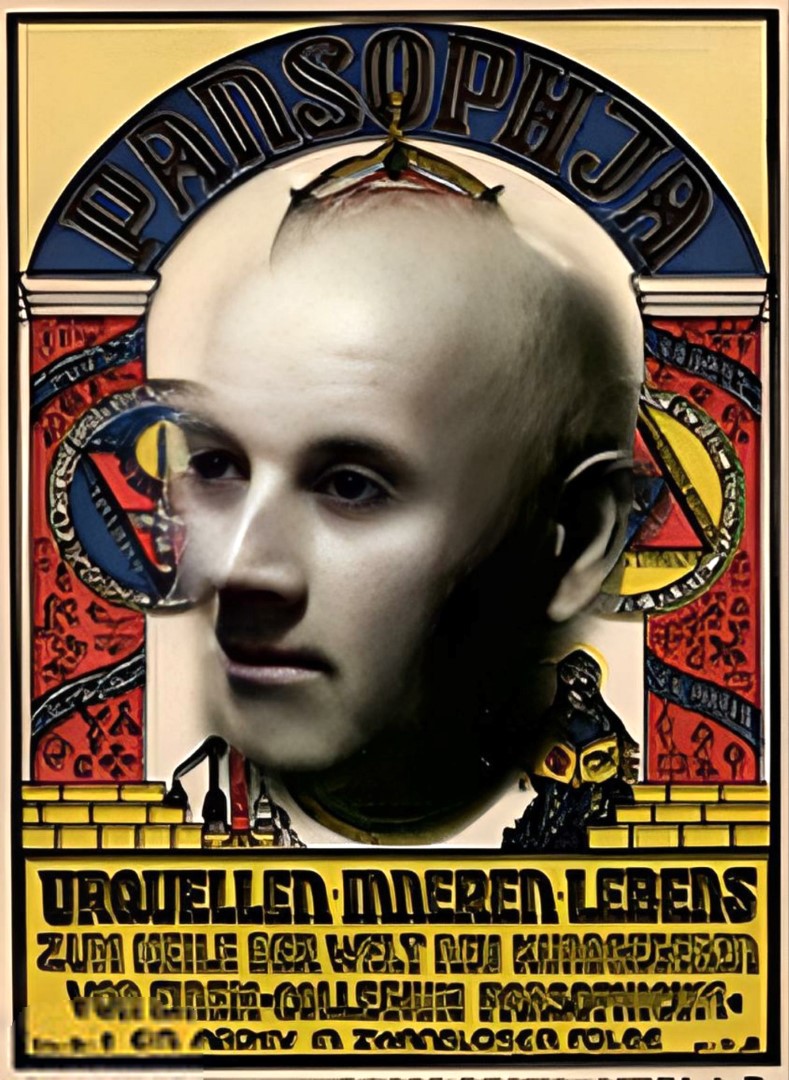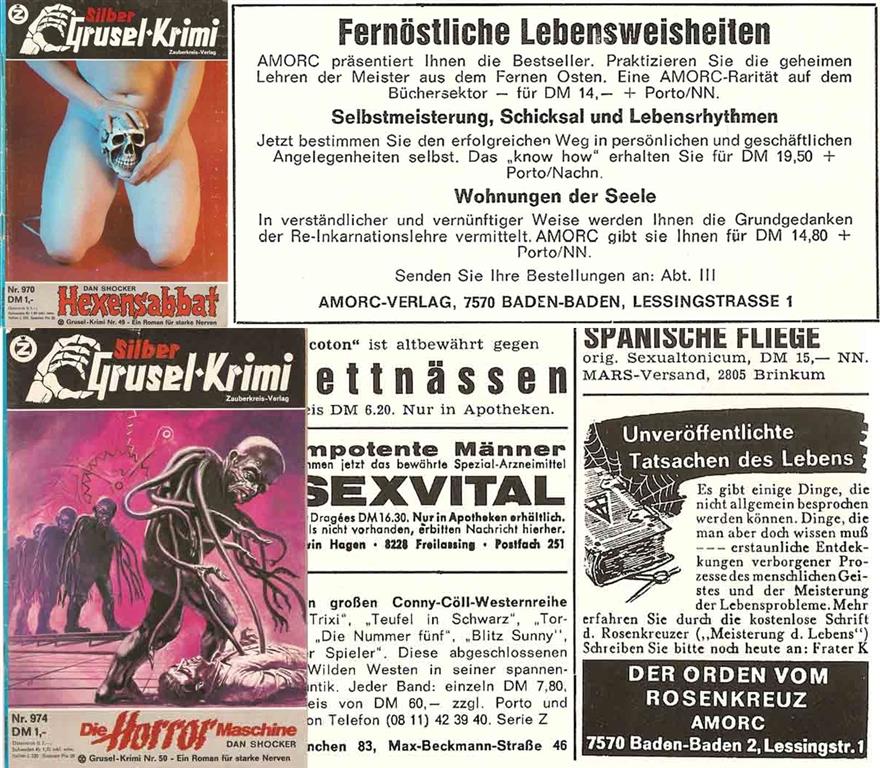My visit to Heinrich Traenker
by H.D. H.

My visit to Heinrich Traenkerby H.D. H. |  |
A.M.O.R.C.When I was about twenty in the early 1950’s, I lived in the American Sector of Berlin, where I worked for the American services for a while. I came across a lot of American publications where the AMORC used to advertise—magazines like ‘Popular Mechanics’. I wrote off and soon became a member of the American AMORC in San José. From there I got hold of the ‘AMORC Bible’, their book called Self-Mastery and Fate with the Cycles of Life by H. Spencer Lewis. I don’t know if this book (which I still have) is still issued in the same form, or if it was ever translated into German. A short time afterwards, R. Lewis (H. Spencer Junior) sent me the address of another AMORC member in Berlin who was in the British sector: Herr Erich Johanssen, an Estonian German, with whom I then got in touch. He had originally been a private tutor to the Tsar’s family, but hadn’t been in their house when they were murdered, only “turning up for work” a few hours later. As a result, he didn’t have a very good reputation with the Russians and had to flee Riga in 1945. It shouldn’t be forgotten that this was 1950—just five years after the war, Berlin was extensively bomb-damaged, and the after-effects of war were everywhere. Anyone in their twenties today, in 2009, can have no idea of the conditions back then. The main impressions people get from books and films about it are often coloured by fifty years of hearsay, just like someone in 1950 might have decribed what happened in 1900.Until this time I was “homeless” in terms of my spiritual knowledge. I had joined the ‘Urania’ Masonic Lodge, but I didn’t really enjoy it—it was more of a club than anything else—so I went on searching, and collected a really extensive library of useful books. Some time afterwards, with Lewis’s permission, I founded the Berlin Pronaos (with about ten members) under the jurisdiction of San José, and later put out a small self-financed Pronaos magazine. I received the correspondence course from San José, but I couldn’t have paid any contributions, because West Germany’s foreign trade was still in such a bad way back then that we weren’t allowed to send money abroad. Incidentally, one of the Berlin AMORC members was the famous Georg Thomalla, for whom I bought an AMORC signet-ring from San José. I don’t know how he came into AMORC, but he didn’t belong to “my” Proanos circle originally. I had mentioned in the magazine that people could buy AMORC merchandise from San José through me, and that was why he made contact. I used a US military post-box number to purchase these items. Meanwhile the jurisdiction for Germany was established in Munich under Grand Master Martin Erler. It was Erler who had reintroduced the AMORC to Germany in 1949—but I knew nothing about this around 1950-51. The name of Eduard Munninger, who considered himself the Austrian inheritor of Arnoldo Krumm-Heller’s “Fraternitas Rosicruciana Antiqua”, was only known to me from the literature. Its order-title of AAORRAC (Antiquus Arcanus Ordo Rosæ Rubeæ Aureæ Crucis) appeared among a number of others in the correspondence-course (I only had the English version) as a proof of AMORC’s authenticity. I knew nothing about Erler’s belief that Munninger’s order was a completely new re-establishment and that AMORC in Germany, then led by Erler, had been amalgamated with it—we never talked about Munninger. The correspondence-courseJohansson and I performed the rituals given in the English correspondence-course together (group-rituals or meetings with the rest of the Berlin membership didn’t happen—we only wrote to each other or met one-to-one).As part of the correspondence-course you had to do experiments to make the aura visible; in these you had to visualise coloured outlines surrounding areas of other shades. Because it was hard to get the trick of this, I built an apparatus for projecting variously-coloured outlines on the wall by remote-control. As agreed, I sent the apparatus to Erler, but I don’t know whether he ever used it or not. It was an electro-mechanical optical device; electronics weren’t as common in those days. (It was a metal case about the size of a shoe-box containing a number of projector-lamps each with a coloured filter [red, blue, green, yellow] and corresponding optics in front of it, so arranged that each threw a coloured sihouette through a projection-lens onto a flat surface like a white wall. Each of the lamps was controlled through a remote circuit, and could be turned down low enough for the coloured silhouette to be only just perceptible, thus allowing the mentally-generated images to be perceived). Heinrich TraenkerJohansson had Herr Traenker’s address; he lived in the Soviet sector (in Pankow, I think it was). Possibly he had got it from Lewis, though so far as I knew Lewis and Traenker had been at loggerheads since 1934. After that the FUDOSI conference took place with the added participation of representatives from the Eglise Gnostique Universelle. Even so FUDOSI was included as a proof of AMORC’s legitimacy in the correspondence course.Because we could see that Traenker’s books and his OTO, Pansophia, etc., weren’t exactly going to harmonise with Soviet socialist ideas while they were in charge of the Russian occupation zone, Herr Johansson and I went to see Traenker some time in 1953 (the Wall hadn’t been put up yet) and advised him to emigrate to Berlin’s US sector, something that I could help to arrange. Back then I still didn’t know just how close Traenker was to Crowley’s OTO—I thought that Crowley’s OTO was quite distinct from Traenker’s OTO. All I did know was that just to mention the name OTO caused problems between every possible sort of person. The Russians—like the Third Reich—would have nothing to do with the esoteric, and even rated it as potentially dangerous. In the occupation-zones I simply knew that Freemasonry—forbidden under the Nazis—was allowed in the three Western zones. Occult groups were also tolerated there—though maybe not so much. What happened about these matters in the east, I can’t say. I suspect that Heinrich Traenker (1880-1956) and Arnoldo Krumm-Heller (1879-1947) had managed to survive wartime Berlin, because during the Third Reich and later they avoided doing anything too “obvious”, i.e. official activities, starting groups or publishing books, which might have seemed “dangerous” to the authorities—such actions would have undoubtedly ended in a book-burning. Traenker showed us his “treasure”; in point of fact his hoard of books and other papers he had hidden away in his cellar, mainly kept on shelves, but also stacked up on tables and in boxes. His house was on an upper ground floor; there was a trap-door under the carpet in his living-room through which you could get down into the cellar—which I remember I found rather impressive at the time. The house was distinctively “lower-middle class” in atmosphere and the furniture was all mixed up. It smelt rather unpleasant. I think one can sum Traenker up as a political innocent. He said that political events were mostly a mystery to him; it never seems to have occurred to him that he was living in Russian-occupied territory. We talked about his books—a few of them were on the OTO—and he showed us some of them down in his cellar. He seemed quite confident that he could still publish his books without any problems. The conversation was rather unusual; Johansson and I were both in a bit of a rush, as visitors from west Berlin weren’t exactly welcome in the Russian sector, and we felt suspicious too, because we really had no idea of why and how Traenker was managing to live in the east. Traenker and his wife seemed mistrustful as well—especially Frau T.—probably because she couldn’t begin to imagine what we were doing there. Perhaps it was another case of political ignorance, but they should have realised that we were only there because of his writings and documents. Traenker and his wife refused to emigrate, and gave us no reasons for this refusal—no, they simply didn’t want to move. I don’t think our visit could have lasted more than a couple of hours. Nor did we talk about any possible organisation that he might lead, let alone recognise, as his Pansophia (or OTO) had been “dormant” during the Third Reich. Traenker mentioned nothing about continuing it, not even a correspondence-circle. Traenker didn’t seem at all senile to me, but he did come across as a bit stubborn in his responses. After that we had no further contact with him, and I never knew what became of him; nor that he died a short while later. One day it would be really interesting to have a look into the old STASI files and see what information they had on him. They must have been concerned about him, if only to make certain that he wasn’t running any sort of “undesirable” organisation inside the DDR. AMORC—ORAAt the start of the fifties Martin Erler made contact with me and we agreed that he should pay a visit to Berlin and meet the members of the Berlin Pronaos. He duly came to see us, and we had a small convention which he himself arranged, with (given the conditions in partitioned Berlin back then) some sumptuous food.One day in 1954 Erler told me (either over the phone or by letter) that he’d left AMORC. Then we heard that in consequence another AMORC jurisdiction for Germany had been established at Baden-Baden. The background to this change was unknown to me—the Baden-Baden people didn’t get in touch with me—nor, so far as I know, did they contact any of the other members of the Berlin Pronaos. We in Berlin were maintaining a worldwide correspondence with AMORC Chapters and Pronaoi—just not with Baden-Baden. Back then I was in contact with (among others) a Coptic dignitary in Cairo, who was apparently running an AMORC Pronaos there too. We didn’t discuss membership-figures, but then I had no ideas about how many members AMORC had in Germany. Then in 1956 Erler founded a German ORA (Ordo Roseæ Aureæ) circle in the Munich area, with himself as its Grand Master. I duly moved over from AMORC to the ORA (formalities apparently being unnecessary). My admission-certificate came from the Netherlands, and was signed by an “Illuminatus” whose name I can’t remember, because this document is no longer in my possession. At the time I was not told that members of the Fraternitas Saturni (as I later discovered) were also supposed to be ORA members. In 1959 the German AMORC moved from Munich to Überlingen; as it was removed from the register of societies in Munich, its membership there must have shrunk to less than three people. Every AMORC member therefore received a form stating that they were transferring from Munich to Überlingen which they had to sign. As I was no longer a member of German AMORC, I didn’t get a form, and only heard that the German AMORC headquarters were now in Überlingen through Erler. It is remarkable that Berlin was kept completely in the dark about these events; we heard nothing about them either from the new German AMORC nor from AMORC San José. Until Erler told me about it, I had absolutely no idea about the changes. AMORC’s activities in Germany seem to have been utterly chaotic in those days—one hand didn’t know what the other was doing—or didn’t want to know, for whatever reason. H.J. MetzgerIn 1962 I moved from Berlin to Fribourg in Switzerland, where I lived and worked until 1969. It was there that I made the acqaintance of H.J. Metzger. We later arranged to hold our meetings in Berne, where we always kept our appointments at a particular restaurant together with some of his other members as well. There were usually about eight people there. It could have been that he had business or professional things to do in Berne, or that he had to meet his local members anyway. I can’t say more on how I met him, but I know it wasn’t at Stein—I was never at Stein.I bought herbs, spices and the like from him. He wanted to recruit me, but because I had already studied the Crowley phenomenon in Berlin with Johansson and others—and got the impression that he was a psychopath—I refused. Johansson had quite a lot of books on or by Crowley which he lent to me. Before that I’d heard nothing about Crowley; I believed that Traenker’s OTO was a straightforward synonym for his, that is Traenker’s, Pansophia. Johansson and I had gained a very wide knowledge of the esoteric “spectrum”, and although we had tried out all the possibilities that we could find out about, in general we had almost no knowledge of the associated organisations. I didn’t speak to Metzger and his people about this subject—only about generalities. I don’t think Metzger really knew what to make of me. As in Berlin, I was very busy with my career in Fribourg, which left me precious little time do serious esoteric work. Sometimes I could put in a few hours here and there, but mostly I could do little or nothing. More on the ORAAt the end of 1969 I moved back to Germany, naturally taking everything with me—especially my books. Due to various events, though, I lost most of my books after 1976—including Traenker’s volumes on Pansophia. Afterwards I had to spend a long time building up a new library, though I was no longer able to get hold of many titles I’d once owned.Later on the ORA convention for the Stuttgart district was held at Geisslingen/Steige, which a lot of members attended (I should say at least thirty), including some from Switzerland. Dr. Gottmann and his wife (an Indian lady) Buddhists from Überlingen—where they were very active in Buddhist matters—had converted from AMORC to ORA and took part in this event. He died at Überlingen in 2005. Another well-known ORA member was Dr. Emil Rahm, who had published a book of ‘Proven Homoeopathic Prescriptions’ through the Turm-Verlag. Did the connection with homeopathy mean that he’d had possible contacts with Krumm-Heller’s Rosicrucian groups? Or (through the publishers) to Lorber? As many of the people at Geisslingen were so clannishly obsessed with different orders, and according to my information caught up in lots of power-struggles, I decided, together with Herr Murer and his wife (Swiss members from Lucerne) that we wouldn’t be going back again, because we expected something different from any Order we belonged to. Herr Murer has since died. SchikowskiDuring my Berlin years up to 1962, Johansson and I (though J. died in about 1958) often used to visit the publisher Schikowski in his bookshop, where we discussed every conceivable subject. Since I was very closely involved in studying the Kabbalah at the time and was coming to certain new conclusions, Schikowski suggested that I should publish this work in book form. But because of my leaving Berlin this scheme came to nothing. The subject of the Fraternitas Saturni was never touched on while we were at Schikowski’s.Final thoughtsIt seems to me as if a generation of occultists—let us call them that—is dying out now, without leaving any proper successors. When I see how everything is dying off, and what these people are putting in its place—whether in a positive or negative sense—I can’t conceive how matters can progress in a sensible way. From now on naturally I foresee things being done out of egotistical motives like power-hunger and ambition. There are many people like that, and psychopaths too, who take themselves to be the elect.© H.D. H, 2009 — email. German original: Mein Besuch bei Heinrich Traenker. Thanks for translation skills go to Mark Parry-Maddocks. |


|
More about Heinrich Traenker:
Also, visit the occult gallery context. O.T.O. Phenomenon navigation page | main page | mail
|
|
|
|